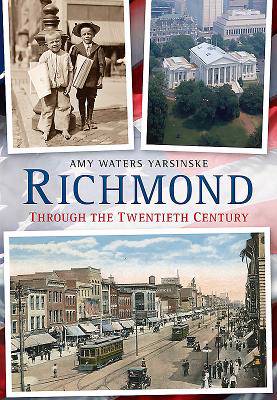
- Afhalen na 1 uur in een winkel met voorraad
- Gratis thuislevering in België vanaf € 30
- Ruim aanbod met 7 miljoen producten
- Afhalen na 1 uur in een winkel met voorraad
- Gratis thuislevering in België vanaf € 30
- Ruim aanbod met 7 miljoen producten
Zoeken
Omschrijving
Richmond is a city with a pedigree, a past that can be traced back to the first English settlers who landed at Jamestown in 1607.
Yet the focus of this volume is the twentieth century, which was, by all rights, America's century and Richmond's rebirth as a modern, changed city.
The closer Richmond moved toward the twentieth century, the more it seemed to be a city of archives and icons, the 'holy city' of the Confederacy, and an American industrial city, reflecting the prosperity and problems of mass production," wrote historian Marie Tyler-McGraw, of the city that had held on so tightly to its status as capital of the Confederacy and bastion of the South's cause in the war.
"The Lost Cause as a form of civil religion for the South was especially evocative in Richmond," McGraw continued, "Yet the political influence of the Lost Cause zealots was probably not as great as its acolytes imagined.
Both politicians and businessmen found the Lost Cause to be a malleable concept, adaptable to new circumstances."
Richmond was ready for a makeover - and it got it.
Yet the focus of this volume is the twentieth century, which was, by all rights, America's century and Richmond's rebirth as a modern, changed city.
The closer Richmond moved toward the twentieth century, the more it seemed to be a city of archives and icons, the 'holy city' of the Confederacy, and an American industrial city, reflecting the prosperity and problems of mass production," wrote historian Marie Tyler-McGraw, of the city that had held on so tightly to its status as capital of the Confederacy and bastion of the South's cause in the war.
"The Lost Cause as a form of civil religion for the South was especially evocative in Richmond," McGraw continued, "Yet the political influence of the Lost Cause zealots was probably not as great as its acolytes imagined.
Both politicians and businessmen found the Lost Cause to be a malleable concept, adaptable to new circumstances."
Richmond was ready for a makeover - and it got it.
Specificaties
Betrokkenen
- Auteur(s):
- Uitgeverij:
Inhoud
- Aantal bladzijden:
- 96
- Taal:
- Engels
Eigenschappen
- Productcode (EAN):
- 9781634990004
- Verschijningsdatum:
- 26/09/2016
- Uitvoering:
- Paperback
- Formaat:
- Trade paperback (VS)
- Afmetingen:
- 173 mm x 246 mm
- Gewicht:
- 453 g

Alleen bij Standaard Boekhandel
+ 72 punten op je klantenkaart van Standaard Boekhandel
Beoordelingen
We publiceren alleen reviews die voldoen aan de voorwaarden voor reviews. Bekijk onze voorwaarden voor reviews.











